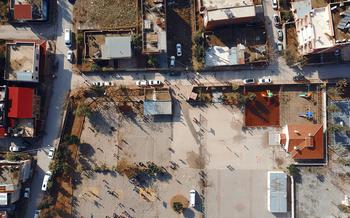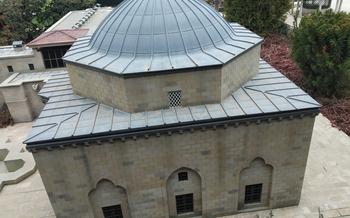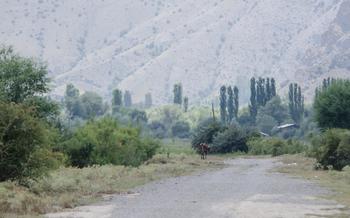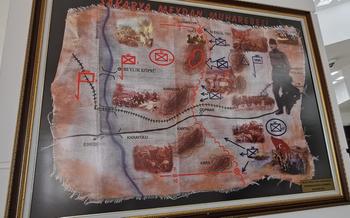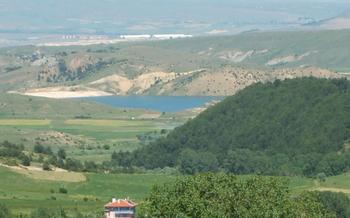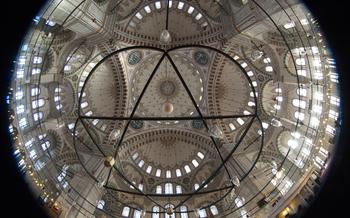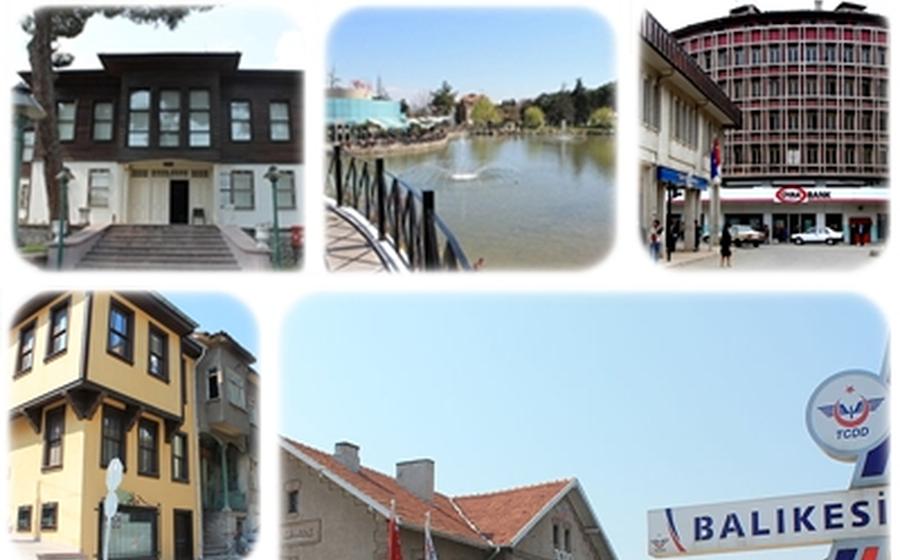
The Hamidiye Mosque
- The Hamidiye Mosque: A Stunning Masterpiece
- Exploring the Mosque's Intricate Details
- Learning about the Mosque's History
- A Place of Worship and Community
- Witnessing the Call to Prayer
- Photography Tips for the Perfect Shot
- Visiting the Mosque During Special Occasions
- The Mosque's Role in Local Traditions
- Historical Context of the Hamidiye Mosque
- The Mosque's Architectural Legacy
- The Mosque's Spiritual Significance
- The Mosque's Social Impact
- The Mosque's Cultural Significance
- The Mosque's Future
- Insider Tip: Respectful Etiquette
The Hamidiye Mosque: A Stunning Masterpiece
The Hamidiye Mosque stands as a breathtaking testament to the architectural prowess and cultural heritage of Balıkesir. Built during the reign of Sultan Abdul Hamid II in the late 19th century, this magnificent structure epitomizes Ottoman grandeur and Islamic artistry. Its soaring minarets pierce the sky, beckoning visitors to delve into the spiritual and historical significance that lies within.
The mosque's awe-inspiring architecture seamlessly blends traditional Ottoman and Seljuk elements, creating a unique masterpiece. Its intricate tilework, elegant calligraphy, and harmonious proportions captivate the senses, inviting visitors to embark on a journey through time.
Beyond its architectural splendor, the Hamidiye Mosque plays a pivotal role in the local community as a vibrant center of worship, education, and social welfare. Its doors remain open to worshippers of all backgrounds, fostering a sense of unity and harmony among the diverse population of Balıkesir.
For visitors seeking a glimpse into the heart and soul of this remarkable city, the Hamidiye Mosque stands as a must-visit destination. Its sacred spaces, rich history, and architectural wonders promise an unforgettable experience that will leave a lasting impression.
Visitor Information: - Timings: The mosque is open for visitors daily from 9 am to 6 pm. - Dress Code: Visitors are expected to dress modestly, covering their shoulders and knees. Women should cover their heads with a scarf. - Etiquette: Visitors should be respectful of the mosque's sanctity, maintaining silence and avoiding disturbing worshippers. Photography is permitted, but it is essential to ask permission before taking pictures inside the mosque.
Exploring the Mosque's Intricate Details
The Hamidiye Mosque stands as a testament to the grandeur of Ottoman architecture. Its exterior is adorned with intricate carvings, colorful tiles, and majestic domes that shimmer in the sunlight. The mosque's courtyard is a peaceful oasis, where visitors can pause and admire the beauty of the surrounding architecture.
Stepping into the mosque's vast prayer hall, visitors are immediately struck by its awe-inspiring grandeur. The hall is supported by rows of towering columns, each adorned with intricate carvings and elegant arches. The ceiling is a masterpiece of Islamic art, featuring intricate geometric patterns and colorful motifs that dance in the light.
The mihrab, the niche indicating the direction of Mecca, is a focal point of the mosque's interior. It is decorated with exquisite tilework, delicate calligraphy, and intricate carvings. The minbar, the pulpit from which the imam delivers his sermons, is another masterpiece of craftsmanship, featuring intricate wooden carvings and inlaid mother-of-pearl.
The Hamidiye Mosque's interior exudes a serene ambiance that encourages contemplation and spirituality. The soft light filtering through the stained-glass windows casts a warm glow on the prayer hall, creating a tranquil atmosphere that invites visitors to find inner peace and connect with the divine.
Learning about the Mosque's History
The Hamidiye Mosque, built during the reign of Sultan Abdul Hamid II, stands as a testament to the grandeur of the Ottoman Empire. Constructed between 1885 and 1890, the mosque reflects the sultan's vision of architectural magnificence and his desire to leave a lasting legacy. The mosque's construction also coincided with a period of significant social and political changes in the empire, making it a symbol of the Ottoman Empire's resilience and adaptability.
The Hamidiye Mosque's significance extends beyond its architectural beauty. It served as a symbol of Ottoman power and authority, representing the sultan's dominance over the region. The mosque's construction was seen as a way to strengthen the empire's control over Balıkesir and to assert its influence in the region.
Over the years, the Hamidiye Mosque has become an integral part of the local religious and cultural traditions. It serves as a place of worship for the Muslim community and hosts various religious festivals and celebrations. The mosque also plays a vital role in promoting Islamic education and preserving local customs and traditions. Its rich history and cultural significance make it a cherished landmark in Balıkesir, respected and revered by both locals and visitors alike.
The mosque's restoration and preservation efforts in recent years have ensured that its architectural grandeur and historical significance will continue to be appreciated by future generations. The mosque's enduring legacy as a symbol of Ottoman power, a center of religious devotion, and a hub of community life makes it a must-visit destination for anyone interested in exploring the rich history and cultural heritage of Balıkesir.
A Place of Worship and Community
The Hamidiye Mosque serves as a crucial religious center for the Muslim community in Balıkesir and beyond. It is a place where the faithful gather for daily prayers, celebrate religious festivals, and seek spiritual guidance. The mosque's spacious prayer hall can accommodate thousands of worshippers, creating a sense of unity and brotherhood among them.
Beyond its religious significance, the Hamidiye Mosque plays a pivotal role in fostering a sense of community among the local residents. It serves as a meeting point for people from all walks of life, providing opportunities for social interaction and exchange. The mosque's courtyard and surrounding areas often host community gatherings, events, and celebrations, strengthening the bonds of kinship and cooperation within the neighborhood.
Recognizing the importance of education, the mosque also operates a madrasah, or Islamic school, where students of all ages can learn about the Quran, Hadith, and Islamic jurisprudence. This educational institution plays a crucial role in preserving and transmitting Islamic knowledge to future generations, ensuring the continuity of Islamic traditions and values within the community.
In addition to its religious and educational functions, the Hamidiye Mosque actively engages in social welfare activities, demonstrating its commitment to the well-being of the community. The mosque's charitable initiatives include providing assistance to the needy, organizing food banks, and supporting educational programs for underprivileged children. Through these efforts, the mosque strives to alleviate poverty, promote social justice, and contribute to the overall development of the community.
Witnessing the Call to Prayer
One of the most captivating experiences for visitors to the Hamidiye Mosque is witnessing the mesmerizing call to prayer, known as the adhan. This sacred call, echoing through the streets of Balıkesir five times a day, is a spiritual moment that resonates with the city's Muslim community.
The adhan, recited by the muezzin from the mosque's minaret, marks the beginning of each prayer time. Its melodic verses, filled with profound spiritual significance, reverberate through the air, inviting the faithful to offer their prayers. The call to prayer serves as a reminder of the mosque's central role in the community, uniting believers in their shared faith and devotion.
For non-Muslim visitors, the adhan offers a glimpse into the deep spiritual traditions of Islam. It is a chance to experience the harmonious blend of faith and culture that permeates the city of Balıkesir. Whether you choose to listen from afar or stand in awe within the mosque's courtyard, the adhan is a captivating moment that leaves a lasting impression on all who hear it.
Photography Tips for the Perfect Shot
To capture the grandeur of the Hamidiye Mosque in your photographs, consider exploring different angles and perspectives. Experiment with shooting from a distance to capture the mosque's imposing presence against the cityscape or move closer to highlight intricate details. Utilize natural light to enhance your photographs, taking advantage of the golden hours around sunrise and sunset for warm and vibrant tones. Remember to respect the sanctity of the mosque when taking photographs, ensuring you do not disturb worshippers or disrupt ongoing religious activities.
Visiting the Mosque During Special Occasions
The Hamidiye Mosque transforms into a spiritual haven during special occasions, particularly during religious festivals and celebrations. The mosque plays a central role in hosting these events, which attract worshippers and visitors from across the region.
During the holy month of Ramadan, the mosque exudes a heightened sense of devotion and spirituality. The mosque's vast prayer hall teems with worshippers engaging in Taraweeh prayers, a special night-time prayer unique to Ramadan. The mosque's ambiance is further enhanced by the recitation of the Quran and the melodious chanting of religious hymns.
Participating in special events at the Hamidiye Mosque offers a truly immersive experience. Visitors can witness the vibrant tapestry of Islamic traditions and customs, from the joyous celebrations of Eid al-Fitr and Eid al-Adha to the solemn observances of Ashura. These events provide a glimpse into the rich cultural heritage of Turkey and the profound role that the mosque plays in the lives of local Muslims.
It is important to approach these special occasions with respect and reverence. Visitors are advised to dress modestly, maintain silence, and avoid disturbing worshippers. By observing proper etiquette, visitors can ensure that they contribute to the harmonious and sacred atmosphere of the mosque during these special times.
The Mosque's Role in Local Traditions
The Hamidiye Mosque plays a significant role in preserving and perpetuating local customs and traditions. It serves as a center for religious education, offering courses and workshops on Islamic teachings and practices. These classes contribute to the preservation of traditional Islamic knowledge and help to instill a sense of cultural identity among the younger generations.
The mosque is also actively involved in charitable activities, providing assistance to those in need within the community. This includes distributing food and clothing to the poor, offering financial aid to students, and supporting families in times of crisis. These charitable endeavors not only demonstrate the mosque's commitment to social welfare but also reinforce traditional values of compassion, generosity, and mutual support.
Furthermore, the mosque plays a vital role in preserving local customs and traditions through its involvement in cultural events and festivals. These events provide a platform for showcasing traditional arts, crafts, and performances, ensuring their continuity and transmission to future generations. The mosque's efforts to promote cultural heritage contribute to the preservation of the city's unique identity and foster a sense of community pride.
Historical Context of the Hamidiye Mosque
The Hamidiye Mosque was constructed during the reign of Sultan Abdul Hamid II, a period marked by significant political and social changes within the Ottoman Empire. The late 19th century witnessed the rise of nationalism and the decline of the empire's power, leading to a period of internal strife and external challenges.
Sultan Abdul Hamid II, known for his efforts to modernize and strengthen the empire, commissioned the construction of the Hamidiye Mosque as a symbol of Ottoman power and prestige. The mosque's grand scale and opulent design reflected the sultan's vision for a revitalized empire, emphasizing its continued commitment to Islamic values and traditions.
The mosque's construction in Balıkesir, a strategically important city in western Anatolia, further underscored its symbolic significance. The city served as a gateway to the Aegean Sea and was home to a diverse population, making it a suitable location to showcase the empire's architectural prowess and religious devotion.
The Hamidiye Mosque thus stands as a testament to the Ottoman Empire's rich history and architectural heritage, embodying the aspirations and challenges of a pivotal era.
The Mosque's Architectural Legacy
The Hamidiye Mosque stands as a testament to the architectural prowess of the Ottoman Empire. It seamlessly blends elements of Ottoman and Seljuk architectural styles, creating a unique and captivating edifice. The mosque's grand dome, intricate tilework, and soaring minarets are reminiscent of the iconic Hagia Sophia in Istanbul, while its use of local materials and traditional construction techniques reflects the influence of Anatolian architecture.
The mosque's construction also marked a significant turning point in Ottoman mosque design. It introduced several innovative features that would become standard in subsequent Ottoman mosques, including the use of a central dome supported by four half-domes, the incorporation of multiple minarets, and the extensive use of tilework for decoration.
The Hamidiye Mosque's architectural legacy extends beyond the borders of Turkey. It served as an inspiration for numerous mosques built throughout the Ottoman Empire and beyond, contributing to the development of Islamic architecture worldwide. Today, it stands as a symbol of the enduring influence of Ottoman architecture and its role in shaping the architectural landscape of the Islamic world.
The Mosque's Spiritual Significance
As a place of worship, contemplation, and spiritual connection, The Hamidiye Mosque holds immense significance for the local Muslim community. It serves as a sanctuary for individuals to seek solace, offer prayers, and strengthen their faith. The mosque's tranquil atmosphere and sacred ambiance provide a conducive environment for worshippers to engage in spiritual practices and deepen their relationship with God.
The mosque's role extends beyond individual devotion, as it fosters a sense of community and togetherness among believers. During congregational prayers, worshippers gather in unity, sharing a common purpose and spiritual experience. The mosque's spacious prayer hall accommodates a large number of worshippers, creating a powerful sense of solidarity and brotherhood.
In addition to daily prayers, The Hamidiye Mosque plays a significant role in religious festivals and celebrations. During Ramadan, the holiest month in the Islamic calendar, the mosque becomes a hub of spiritual activity, with special prayers, recitations, and communal gatherings taking place throughout the night. The mosque's vibrant atmosphere during these occasions reflects the deep spiritual connection that the community feels towards their place of worship.
The mosque's spiritual significance is further enhanced by its rich history and architectural beauty. The intricate details, exquisite craftsmanship, and harmonious design of the mosque inspire a sense of awe and reverence among visitors. The mosque's unique blend of Ottoman and Seljuk architectural styles creates a visually stunning and spiritually uplifting environment that encourages contemplation and reflection.
Overall, The Hamidiye Mosque stands as a testament to the spiritual and cultural heritage of Balıkesir. Its enduring significance lies in its ability to provide a sacred space for worship, foster a sense of community, and promote spiritual growth and development among believers.
The Mosque's Social Impact
The Hamidiye Mosque has played a significant role in providing education and social services to the local community. It has established a madrasah (Islamic school) within its premises, offering religious education to children and adults. Additionally, the mosque organizes various educational programs, workshops, and seminars on Islamic teachings, history, and culture.
The mosque also serves as a center for social welfare activities. It provides financial assistance to the needy, distributes food and clothing to the poor, and supports orphans and widows. Furthermore, the mosque operates a medical clinic that offers free healthcare services to the community, regardless of their religious affiliation.
The mosque's efforts to promote social cohesion and harmony are evident in its initiatives to bring together people from diverse backgrounds. It organizes interfaith dialogue events, cultural exchange programs, and community gatherings that foster understanding, respect, and cooperation among different religious and ethnic groups.
The mosque's commitment to empowering women and youth is reflected in its programs and activities designed to support their personal and professional development. It offers vocational training courses for women, provides scholarships to deserving students, and organizes workshops on leadership, entrepreneurship, and financial literacy for young people.
Through these social initiatives, the Hamidiye Mosque has become an integral part of the community, contributing to its social, economic, and cultural well-being. It serves as a beacon of hope, guidance, and support for people from all walks of life, promoting a sense of unity, compassion, and social responsibility.
The Mosque's Cultural Significance
The Hamidiye Mosque holds immense cultural significance, deeply intertwined with the city's identity. It stands as a testament to the region's rich Islamic heritage and the harmonious blending of cultures that has shaped Balıkesir's unique character. The mosque has played a pivotal role in preserving and promoting Turkish Islamic culture, serving as a center for religious learning, cultural exchange, and community gatherings.
Through its architectural grandeur, intricate craftsmanship, and spiritual aura, the mosque has become an iconic symbol of Balıkesir's cultural heritage. It attracts visitors from near and far, who come to admire its beauty, learn about its history, and experience the vibrant Islamic culture that permeates the city. The mosque has become a symbol of unity and diversity, bringing people of different backgrounds together to celebrate their shared cultural heritage.
Moreover, the mosque has been instrumental in promoting cultural exchange and understanding. It has hosted numerous events, workshops, and exhibitions that showcase Islamic art, music, and literature. These events provide a platform for dialogue and interaction, fostering a greater appreciation for the richness and diversity of Islamic culture. The mosque has also played a crucial role in preserving and protecting cultural heritage, working to restore and maintain historical artifacts and manuscripts.
The Hamidiye Mosque stands as a living testament to the enduring power of culture, bridging the past and the present, and inspiring future generations to embrace and celebrate their heritage.
The Mosque's Future
The Hamidiye Mosque stands as a testament to the enduring legacy of Ottoman architecture and Islamic culture. As we look towards the future, the mosque faces both challenges and opportunities. Plans are underway for its conservation and restoration, ensuring its preservation for generations to come. The mosque's role in the sustainable development of Balıkesir is also being explored, with a focus on preserving its historical and cultural significance while promoting responsible tourism practices.
The mosque's potential to attract tourists and promote cultural tourism is immense. Its unique architectural features, historical significance, and spiritual atmosphere make it a compelling destination for travelers from around the world. By promoting the mosque's cultural heritage and encouraging responsible tourism, the local community can benefit economically while preserving the mosque's sanctity and authenticity.
Furthermore, the Hamidiye Mosque can continue to contribute to the future of Islamic architecture and culture. Its unique blend of Ottoman and Seljuk styles, along with its spiritual significance, makes it a valuable resource for architects, historians, and scholars. By studying and documenting the mosque's architectural details, construction techniques, and cultural significance, we can gain valuable insights into the evolution of Islamic architecture and its impact on global cultural heritage.
In conclusion, the Hamidiye Mosque stands as a beacon of history, culture, and spirituality in Balıkesir. Through conservation efforts, responsible tourism, and continued research, the mosque can continue to inspire and enrich the lives of both local residents and visitors alike, ensuring its legacy for generations to come.
Insider Tip: Respectful Etiquette
As a visitor to the Hamidiye Mosque, it is essential to observe respectful etiquette to honor its sacred nature and the religious practices of the local community. Here are some guidelines to keep in mind:
-
Dress modestly and appropriately: When visiting the mosque, ensure your attire is modest and respectful. Avoid wearing shorts, revealing clothing, or anything that might be considered offensive or disrespectful in a religious setting.
-
Remove your shoes before entering the prayer hall: Before stepping onto the prayer mats in the main prayer hall, remove your shoes and place them neatly in the designated shoe racks. This is a common practice in mosques to maintain cleanliness and purity in the prayer space.
-
Maintain silence and avoid disturbing worshippers: While exploring the mosque, be mindful of the worshippers and maintain a respectful silence. Avoid loud conversations, laughter, or any behavior that might disrupt their prayers or contemplation.
-
Ask permission before taking photographs: If you wish to take photographs inside the mosque, it is considered polite to ask permission from the mosque's caretaker or a local authority. Be respectful of the privacy of worshippers and avoid taking pictures of individuals without their consent.
